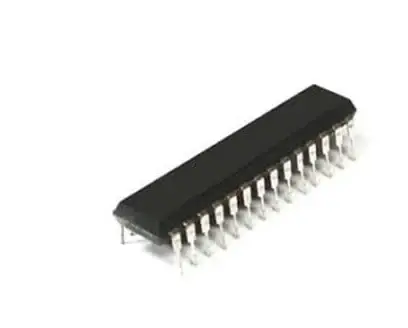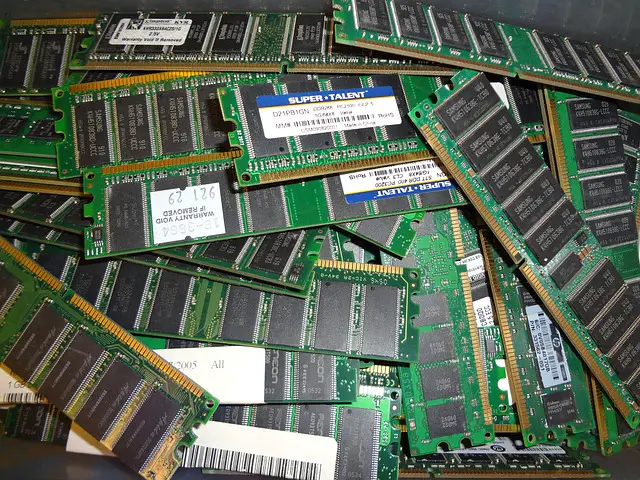DRAM and SRAM are both types of computer memory. DRAM is a type of volatile memory that can store data more quickly than SRAM, making it ideal for applications such as gaming and video editing. However, it requires continual power to maintain its contents; otherwise the data will be lost. On the other hand, SRAM is a non-volatile form of memory that does not require power to retain its content and thus can be used for applications where long-term storage is required.
DRAM
(Photo by Possessed Photography on Unsplash )

DRAM stands for Dynamic Random Access Memory, which is a type of computer memory that stores each bit of data in a separate capacitor within an integrated circuit. DRAM is the most common type of volatile memory used in personal computers, servers, and other digital devices.
DRAM is called “dynamic” because it needs to be refreshed periodically to maintain its data. Unlike static RAM (SRAM), which uses flip-flops to store data, DRAM requires constant power to maintain its state, and its contents are lost when power is turned off.
DRAM is widely used in modern computers because it provides a large amount of storage capacity at a relatively low cost. However, it is slower than SRAM and other types of memory, and it consumes more power. DRAM comes in various forms, including DDR (double data rate) and GDDR (graphics double data rate) memory, which are commonly used in personal computers and graphics cards, respectively.
SRAM

SRAM stands for Static Random Access Memory, which is a type of computer memory that stores each bit of data using a flip-flop circuit. SRAM is a type of volatile memory, which means that its contents are lost when power is turned off.
SRAM is called “static” because it does not require constant refreshing like DRAM. The stored data is maintained as long as power is supplied to the chip. SRAM is typically faster and more power-efficient than DRAM, but it is also more expensive and has a lower storage density.
SRAM is commonly used as cache memory in modern computers to provide fast access to frequently used data. It is also used in other applications that require fast and reliable access to data, such as embedded systems and high-performance network switches.
SRAM comes in various forms, including synchronous and asynchronous types, and it is often used in combination with DRAM to provide a balance of performance and cost in computer memory systems.
DRAM Vs. RAM – Key differences
DRAM and RAM are often used interchangeably, but technically, RAM (Random Access Memory) is a broader category that includes both DRAM (Dynamic Random Access Memory) and SRAM (Static Random Access Memory). Here are some key differences between DRAM and RAM:
Volatility: Both DRAM and SRAM are volatile, which means that their contents are lost when power is turned off. In contrast, non-volatile memory like hard disk drives and solid-state drives retain their contents even when power is turned off.
Technology: DRAM and SRAM use different technologies to store data. DRAM stores each bit of data in a separate capacitor, while SRAM uses flip-flops. This fundamental difference affects factors such as speed, cost, and power consumption.
Speed: SRAM is generally faster than DRAM because it does not require refreshing to maintain its contents. This makes SRAM suitable for use as cache memory, where fast access to frequently used data is important.
Cost: DRAM is generally cheaper than SRAM in terms of cost per bit. This makes DRAM suitable for use as main memory, where large amounts of storage capacity are needed.
Power consumption: DRAM consumes more power than SRAM due to the need to constantly refresh its contents. This can make DRAM less suitable for battery-powered devices or other applications where power consumption is a concern.
RAM is a broader category that includes both DRAM and SRAM, and the choice between the two depends on factors such as cost, speed, and power consumption.
Applications of DRAM and SRAM
DRAM and SRAM are used in various applications where fast, volatile memory is needed. Here are some examples:
Applications of DRAM:
- Main memory in personal computers and servers
- Graphics cards in gaming and video editing applications
- Mobile devices, such as smartphones and tablets
- Automotive systems, such as navigation and entertainment systems
- Industrial and embedded systems, such as robotics and automation control
Applications of SRAM:
- Cache memory in personal computers and servers
- Processor registers in microprocessors
- High-performance network switches and routers
- Automotive systems, such as engine control units and advanced driver assistance systems (ADAS)
- Aerospace and defense applications, such as avionics and radar systems
DRAM is used in applications where large amounts of memory are needed at a relatively low cost, while SRAM is used in applications where speed and low power consumption are more important than cost and storage capacity. However, there is some overlap in their applications, and the choice between DRAM and SRAM depends on the specific requirements of each application.
What is the difference between DRAM and SDRAM?
The main difference between DRAM and SDRAM is that DRAM is slower than SDRAM. This is because SDRAM can be accessed in a burst mode, whereas DRAM can only be accessed one byte at a time.
SDRAM also has a higher data density than DRAM, meaning that more data can be stored in the same amount of space. This is because SDRAM uses less power than DRAM and so can be packed more densely onto a chip.
Finally, SDRAM is cheaper to produce than DRAM. This is because the manufacturing process for SDRAM is simpler than for DRAM, and so less expensive.
Is SRAM is faster than DRAM?
Yes, SRAM is generally faster than DRAM. SRAM does not require constant refreshing to maintain its contents, which means that it can access data much more quickly than DRAM. In contrast, DRAM needs to refresh each memory cell periodically to maintain the stored data, which introduces some latency and reduces its speed.
SRAM is typically used in applications that require very fast access to memory, such as cache memory in CPUs and high-speed networking equipment. In contrast, DRAM is used as main memory in personal computers and servers, where its lower cost and higher storage density make it a more practical choice.
It’s worth noting that there are various factors that affect the speed of both SRAM and DRAM, including the specific implementation and architecture of the memory chip. But in general, SRAM is faster than DRAM due to its simpler structure and lower latency.
The advantages and disadvantages of SRAM
SRAM (Static Random Access Memory) has several advantages and disadvantages that affect its suitability for various applications. Here are some of the main advantages and disadvantages of SRAM:
Advantages:
- Speed: SRAM is faster than DRAM due to its simpler structure and lower latency. This makes it well-suited for applications where fast access to data is important.
- Power consumption: SRAM consumes less power than DRAM because it does not need to be constantly refreshed. This makes it a better choice for battery-powered devices or other applications where power consumption is a concern.
- Durability: SRAM is more durable than DRAM because it is less susceptible to data loss caused by power interruptions or other disturbances.
- Reliability: SRAM is more reliable than DRAM because it does not require periodic refreshing to maintain its contents, which reduces the risk of data corruption or loss.
Disadvantages:
- Cost: SRAM is generally more expensive than DRAM in terms of cost per bit. This makes it less suitable for applications that require large amounts of storage capacity.
- Storage density: SRAM has a lower storage density than DRAM because it uses more transistors per bit of data. This makes it less suitable for applications where storage density is important.
- Size: SRAM is larger than DRAM because it requires more transistors per bit of data. This makes it less suitable for applications where physical size is a concern.
- Complexity: SRAM is more complex than DRAM because it requires additional circuitry to implement the flip-flop storage cells. This complexity can increase the risk of manufacturing defects and reduce yields.
SRAM is a fast and reliable type of memory that is well-suited for applications that require fast access to data and low power consumption. However, it is more expensive and less dense than DRAM, which limits its suitability for certain applications.
The advantages and disadvantages of DRAM
DRAM (Dynamic Random Access Memory) has several advantages and disadvantages that affect its suitability for various applications. Here are some of the main advantages and disadvantages of DRAM:
Advantages:
- Cost: DRAM is generally less expensive than SRAM in terms of cost per bit. This makes it a more practical choice for applications that require large amounts of storage capacity.
- Storage density: DRAM has a higher storage density than SRAM because it uses fewer transistors per bit of data. This makes it well-suited for applications where storage density is important.
- Size: DRAM is smaller than SRAM because it requires fewer transistors per bit of data. This makes it well-suited for applications where physical size is a concern.
- Simplicity: DRAM is simpler than SRAM because it uses capacitors to store each bit of data, which requires less circuitry than the flip-flop storage cells used in SRAM.
Disadvantages:
- Speed: DRAM is slower than SRAM because it requires periodic refreshing to maintain its contents. This introduces some latency and reduces its speed.
- Power consumption: DRAM consumes more power than SRAM because it requires constant refreshing to maintain its contents. This makes it less suitable for battery-powered devices or other applications where power consumption is a concern.
- Durability: DRAM is less durable than SRAM because it is more susceptible to data loss caused by power interruptions or other disturbances.
- Reliability: DRAM is less reliable than SRAM because it requires periodic refreshing to maintain its contents, which increases the risk of data corruption or loss.
DRAM is a cost-effective and high-density type of memory that is well-suited for applications that require large amounts of storage capacity. However, it is slower and less reliable than SRAM, which limits its suitability for certain applications that require high speed or low power consumption.
Featured Image By – Joshua Robins from Pixabay








